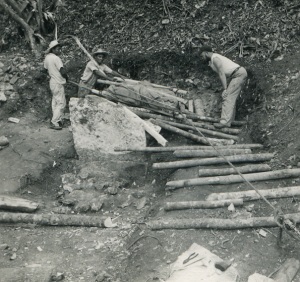Earlier this week I spent some time working on the collections of Linton Satterthwaite relating to the archaeological investigations in Caracol, Belize. The expeditions, in 1951 and 1953, were primarily focused on the salvage and documentation of stelae, the large carved monuments erected by the ancient Maya to commemorate rulers or historic events. They recovered many broken stelae and tried to deduce how the pieces fit together.
Before they moved anything from the site, however, they documented the fragments carefully. Scholars of Maya hieroglyphs, such as Satterthwaite, did not yet understand the writing system of the ancient Maya, (which has really only been deduced in the last twenty years) but intensively studied them nonetheless. And they had found that viewing a carving with light striking it from different angles could reveal details invisible under normal conditions.


So the archaeological team would stay up late, and photograph the pieces in the dark, with an oil lamp for light. Many long nights in the jungle.

The next step was moving and packing up the stelae. This involved cutting down trees to create crates, and setting up rigging to move them. Which meant long days of hard work in the jungle.



As I know from my own fieldwork experience, long days of work require some diversions, and any good project director will allow a few:

Many of the stelae were transported to the Belizean Department of Archaeology, and some shipped all the way to the University of Pennsylvania Museum.
On display in the Mesoamerican gallery now, (among others) are:
Stela 6, from AD 603. It depicts, on one side, the ruler Flaming Ahaw holding a double-headed serpent bar, accompanied by a dwarf, and standing on the body of a naked captive. The other side features his predecessor, Lord Water, wearing the marks of a deity, such as curled motif around his eye. The sky-band above him is made of snakes with heads projecting out of their mouths – often a depiction of how the spirits of the ancestors come to visit their royal descendants. The hieroglyphic texts on the side of the stela are important because they indicate that the city of Caracol was subordinate to the city-state of Tikal.
Altar 13, dated AD 830. It probably shows a ceremony of a ruler’s accession to the throne. The four-sided figure that the figures stand inside most likely indicates a cave or some other symbolic portal to the Other World.

For Further Research:
The monuments and inscriptions of Caracol, Belize By Carl P. Beetz, Linton Satterthwaite.
Breaking the Maya Code by Michael Coe -an excellent overview of Maya hieroglyphs and their decipherment.
The Caracol Archaeological Project website, for the excavations now directed by Arlen & Diane Chase.
